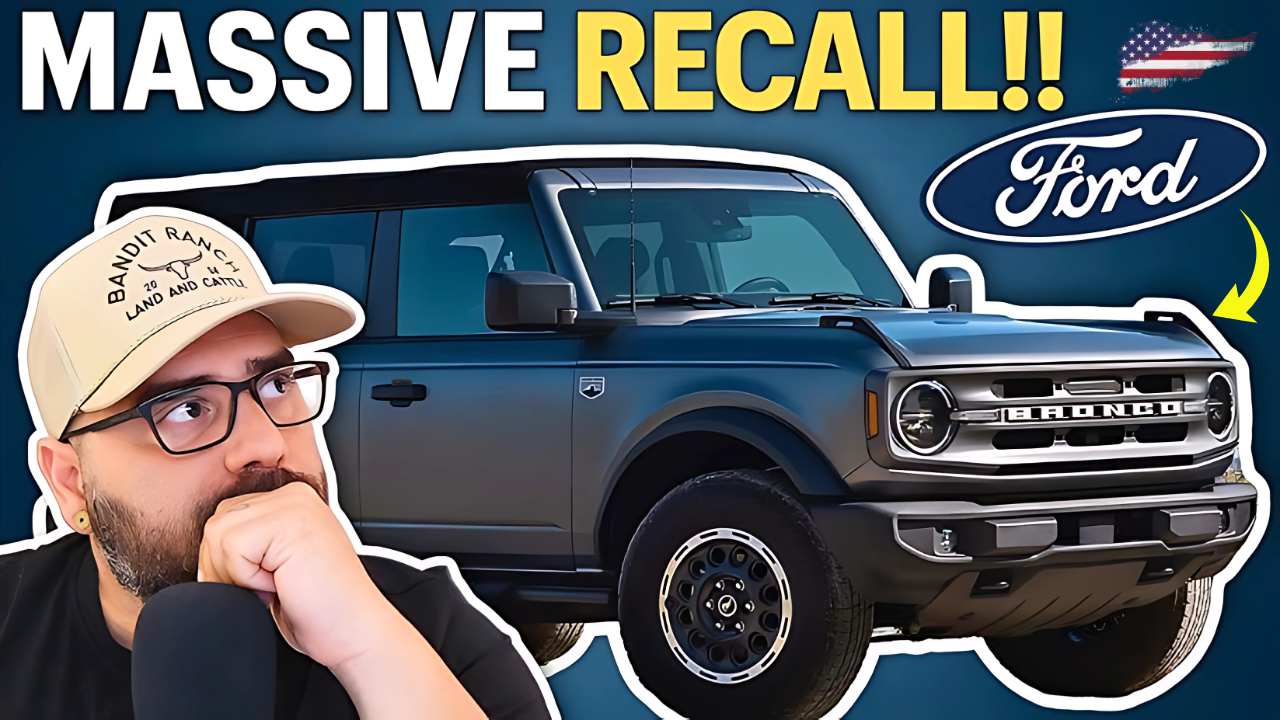The automotive industry witnessed another significant safety announcement this week as Ford Motor Company issued a comprehensive recall affecting more than 1.1 million vehicles across the United States. This massive recall, officially documented as affecting 1,075,299 vehicles, centers around a troubling software defect that compromises one of modern driving’s most essential safety features – the rearview camera system.
The recall announcement has sent ripples through the automotive community, particularly because it affects such a wide range of popular Ford models spanning multiple model years. From the rugged Bronco to the dependable F-150, and from family-friendly SUVs to commercial work trucks, this recall touches virtually every segment of Ford’s current lineup.

Understanding the Technical Problem
The core issue lies within what technicians call the accessory protocol interface module, commonly known as APIM software. Think of this as the brain that controls your vehicle’s infotainment system – it’s the sophisticated operating system that manages everything from navigation maps to smartphone connectivity and, crucially, your rearview camera display.
When this software encounters a glitch, the consequences can be immediate and dangerous. Drivers backing up their vehicles may suddenly find themselves staring at a blank screen, a frozen image from seconds earlier, or experiencing significant delays in the camera feed. Imagine the scenario: you’re backing out of a parking space at a busy shopping center, relying on your rearview camera to ensure no pedestrians or vehicles are behind you, only to discover the screen isn’t showing you what’s actually happening in real-time.
What makes this particularly concerning is the unpredictable nature of the malfunction. There are no warning signs, no dashboard alerts, and no indication that the system is about to fail. One moment you have a functioning rearview camera, and the next moment you’re essentially driving blind when reversing.
The Extensive List of Affected Vehicles
The scope of this recall is truly staggering when you consider the variety of vehicles involved. Ford’s 2021-2024 Bronco models are included, which is particularly significant given the SUV’s recent return to the market and its popularity among outdoor enthusiasts. The legendary F-150 pickup truck, America’s best-selling vehicle for decades, is represented across the 2021-2024 model years.
Family vehicles haven’t escaped this net either. The Ford Edge (2021-2024) and Escape (2023-2024) represent two of Ford’s most popular SUV offerings for families and commuters. Lincoln luxury vehicles are equally affected, with the Corsair (2023-2024), Nautilus (2021-2023), and Navigator (2022-2024) all requiring attention.
Ford’s commercial vehicle lineup faces significant disruption as well. The F-250, F-350, F-450, F-550, and F-600 Super Duty trucks (2023-2024 model years) serve as the backbone for countless businesses across America. Construction companies, delivery services, and municipal fleets rely heavily on these vehicles, making this recall a potential operational nightmare for many organizations.
The list continues with the Expedition (2022-2024), Transit van (2022-2025), Mustang Mach-E (2021-2023), Ranger pickup (2024), and even the iconic Mustang (2024). This comprehensive coverage across Ford’s entire portfolio demonstrates just how widespread the software implementation was – and consequently, how extensive the problem has become.
The Road to Discovery
The journey to this recall began with what many would consider routine customer complaints. In January, the National Highway Traffic Safety Administration (NHTSA) received its first batch of concerns – approximately three dozen complaints specifically targeting Ford F-150 models from the 2021-2023 production years.
These weren’t isolated incidents of minor inconvenience. Vehicle owners were reporting real safety concerns about their rearview cameras failing at critical moments. The complaints painted a picture of a systematic problem that went far beyond occasional technical hiccups.
Ford’s investigation revealed that at least one minor collision had already occurred, directly attributed to this camera malfunction. While thankfully no injuries or fatalities resulted from this particular incident, the property damage served as a stark reminder of what could happen when essential safety systems fail unexpectedly.
The Solution and Implementation Timeline
Fortunately, the fix for this widespread problem is relatively straightforward, though it requires careful coordination across Ford’s vast network. The solution involves updating the APIM software that controls the rearview camera system. This can be accomplished through two primary methods, depending on the specific vehicle and its capabilities.
Many newer Ford vehicles come equipped with over-the-air update capabilities, similar to how your smartphone receives system updates. For these vehicles, owners simply need to ensure their car is connected to a reliable Wi-Fi network, and Ford can push the necessary software update remotely. This represents the most convenient solution for tech-savvy owners with compatible vehicles.
However, not all affected vehicles have this over-the-air capability, and some owners may prefer the assurance of having a professional technician handle the update. In these cases, Ford dealerships across the country are prepared to perform the software update manually. The process typically takes less than an hour and doesn’t require any physical parts replacement.
Ford has established a clear communication timeline for affected owners. Dealers received official notification of the recall on May 12, giving them time to prepare their service departments and train technicians on the update procedure. Vehicle owners should expect to receive their official recall notices by mail between May 19 and May 23, providing detailed instructions on how to proceed.
Ford’s Troubling Recall Record
This latest recall adds to what has become an unfortunately familiar pattern for Ford Motor Company. According to industry tracking data, Ford has already issued over 50 recalls in 2025 alone, significantly outpacing its closest competitors and reclaiming the dubious distinction of leading all manufacturers in recall frequency.
To put this in perspective, the Volkswagen Group holds second place with just 14 recalls through mid-May. General Motors and Stellantis North America are tied for third with 11 recalls each. Mercedes-Benz and Honda round out the top tier with 9 recalls apiece. The gap between Ford and its nearest competitor is not just significant – it’s practically unprecedented.
This recall dominance isn’t a new phenomenon for the Michigan-based automaker. Ford has historically struggled with quality control issues, earning the unfortunate distinction of having issued more recalls than any other manufacturer in automotive history. The F-150 pickup truck, despite being America’s best-selling vehicle, has been disproportionately represented in these safety actions.
Industry Context and Consumer Impact
The automotive industry’s relationship with recalls has evolved dramatically over the past decade. Modern vehicles contain more sophisticated technology than ever before, creating new opportunities for both innovation and failure. Software-related recalls, like this Ford rearview camera issue, represent a growing category of safety concerns that didn’t exist in earlier automotive eras.
For consumers, this recall underscores the importance of staying informed about their vehicle’s safety status. The NHTSA maintains comprehensive databases of all automotive recalls, and owners should regularly check whether their vehicles are affected by any safety actions.
The financial impact on Ford is substantial, though the company hasn’t disclosed specific costs associated with this recall. Beyond the immediate expenses of software development, dealer coordination, and customer communication, there are longer-term reputational costs that can affect sales and brand loyalty.
Prevention and Accountability
This recall raises important questions about Ford’s quality assurance processes, particularly regarding software testing and validation. How does a defect affecting over one million vehicles make it through multiple stages of testing and quality control? What changes in Ford’s development process might prevent similar widespread issues in the future?
The automotive industry is watching closely to see how Ford responds beyond just fixing the immediate problem. Consumers and industry analysts will be looking for evidence of systematic improvements in Ford’s design and testing procedures.
Meanwhile, vehicle owners affected by this recall should take prompt action once they receive their official notices. While no injuries have been reported beyond the single minor collision, the potential for more serious accidents remains real until the software update is completed.
Frequently Asked Questions
How do I know if my Ford vehicle is affected by this recall?
Check your vehicle identification number (VIN) against Ford’s recall database or wait for your official mail notice arriving between May 19-23.
Will the software update cost me anything?
No, all recall-related repairs and updates are provided free of charge by Ford, whether performed at a dealership or through over-the-air update.
Can I still drive my vehicle safely while waiting for the update?
Yes, but exercise extra caution when reversing and don’t rely solely on the rearview camera – use mirrors and direct visual inspection as backup methods.


